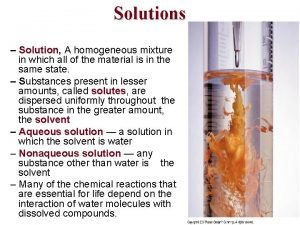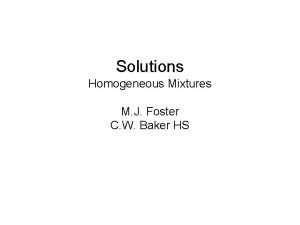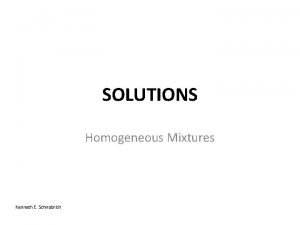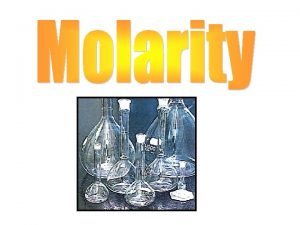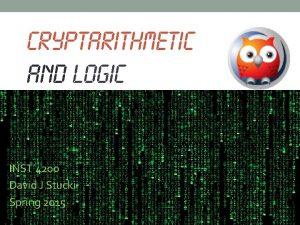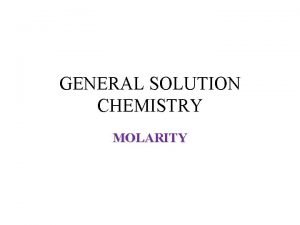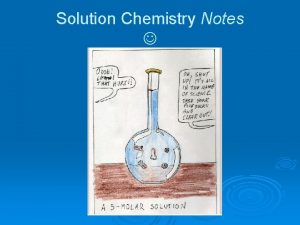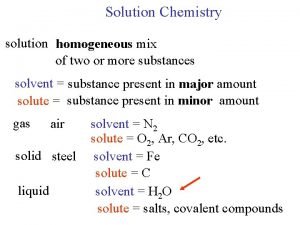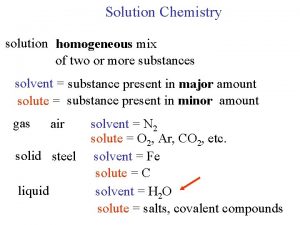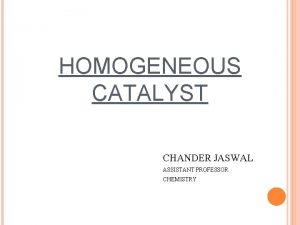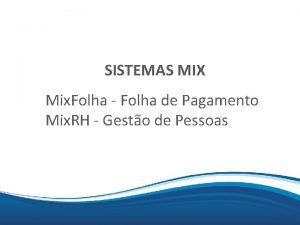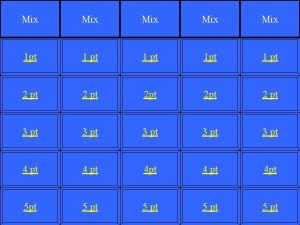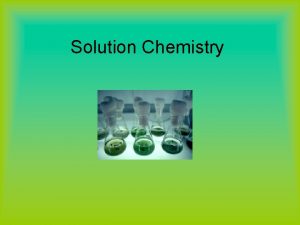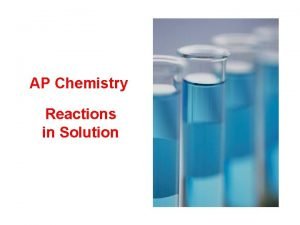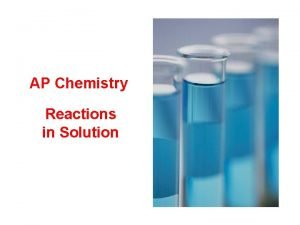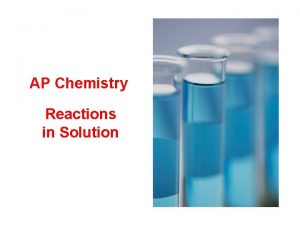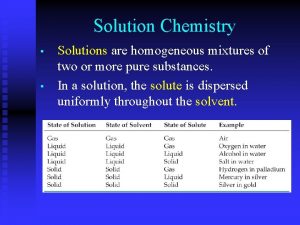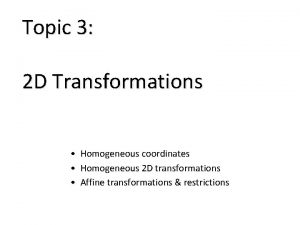Solution Chemistry solution homogeneous mix of two or










![Solution Composition molarity concentration = amount of solute = mol = [ M ] Solution Composition molarity concentration = amount of solute = mol = [ M ]](https://slidetodoc.com/presentation_image_h2/06dd054bdc4a08c3bd63241e2bbddf1c/image-11.jpg)
![Solution Composition concentration = amount of solute = mol = [ M ] volume Solution Composition concentration = amount of solute = mol = [ M ] volume](https://slidetodoc.com/presentation_image_h2/06dd054bdc4a08c3bd63241e2bbddf1c/image-12.jpg)
![Solution Composition concentration = amount of solute = mol = [ M ] volume Solution Composition concentration = amount of solute = mol = [ M ] volume](https://slidetodoc.com/presentation_image_h2/06dd054bdc4a08c3bd63241e2bbddf1c/image-13.jpg)
![Solution Composition concentration = amount of solute = mol = [ M ] volume Solution Composition concentration = amount of solute = mol = [ M ] volume](https://slidetodoc.com/presentation_image_h2/06dd054bdc4a08c3bd63241e2bbddf1c/image-14.jpg)

- Slides: 15

Solution Chemistry solution homogeneous mix of two or more substances solvent = substance present in major amount solute = substance present in minor amount gas air solid steel liquid solvent = N 2 solute = O 2, Ar, CO 2, etc. solvent = Fe solute = C solvent = H 2 O solute = salts, covalent compounds

H 2 O + + - O and H share electrons but not equally separation of charge dipole moment polar solvent hydrogen bonds H-bond + need donor H-O acceptor O + H-N N + H-F F

solvent H 2 O H-bond H + O - Aqueous solutions Ion-dipole Cl- H + Na+ O solvation solute Na. Cl Ion-ion Na+ Cl- Na. Cl (s) + H 2 O (l) Na+ (aq) + Cl- (aq)

Non-ionic solutions solvent H 2 O glucose H-bond H + O - solute C 6 H 12 O 6 H-bond H + O C 6 H 12 O 6 (s) + H 2 O (l) C 6 H 12 O 6 (aq) “Likes dissolve likes”

Non-ionic solutions solvent H 2 O octane solute C 8 H 18 non-polar H-bond H + O C 8 H 18 (l) + H 2 O (l) no reaction

Properties of aqueous solutions ionic covalent conduct electricity do not conduct electricity Na. Cl C 6 H 12 O 6 electrolytes produce ions non-electrolytes mobile, charged salts produce other anions and cations bases produce OH- in aqueous solutions acids produce H+ in aqueous solutions

Electrolytes Rule Exceptions 1. Most acids are weak electrolytes HCl HBr HI HNO 3 H 2 SO 4 HCl. O 4 2. Most bases are weak electrolytes Li. OH – Cs. OH Ca(OH)2 – Ba(OH)2 3. Most salts are strong electrolytes Hg. Cl 2 Hg(CN)2

Strong Electrolytes dissociate completely form hydrated ions strong acids HCl (g) + H 2 O (l) H+ (aq) + Cl- (aq) strong bases Na. OH (s) + H 2 O (l) Na+ (aq) + OH- (aq) salts Mg. SO 4 (s) + H 2 O (l) Mg 2+(aq) + SO 42 -(aq)

Weak Electrolytes do not dissociate completely equilibrium all species present weak acids HF (g) + H 2 O (l) H+ (aq) + F- (aq) weak bases NH 3 (g) + H 2 O (l) NH 4+ (aq) + OH- (aq) weak electrolytic salts Hg. Cl 2 (s) + H 2 O (l) Hg 2+ (aq) + 2 Cl- (aq)

Non- Electrolytes do not dissociate to form ions CH 3 CH 2 OH (l) + H 2 O CH 3 CH 2 OH (aq)
![Solution Composition molarity concentration amount of solute mol M Solution Composition molarity concentration = amount of solute = mol = [ M ]](https://slidetodoc.com/presentation_image_h2/06dd054bdc4a08c3bd63241e2bbddf1c/image-11.jpg)
Solution Composition molarity concentration = amount of solute = mol = [ M ] volume of solution L What is the molarity of a solution prepared by dissolving 23. 4 g sodium sulfate in enough water to give 125 m. L of solution? 23. 4 g Na 2 SO 4 1 mol Na 2 SO 4 = 0. 165 mol Na 2 SO 4 142. 0 g Na 2 SO 4 125 m. L 1 L =. 125 L 1000 m. L M = 0. 165 mol Na 2 SO 4 = 1. 32 M 0. 125 L [Na 2 SO 4] = 1. 32 M
![Solution Composition concentration amount of solute mol M volume Solution Composition concentration = amount of solute = mol = [ M ] volume](https://slidetodoc.com/presentation_image_h2/06dd054bdc4a08c3bd63241e2bbddf1c/image-12.jpg)
Solution Composition concentration = amount of solute = mol = [ M ] volume of solution L How many moles of HNO 3 are present in 2. 0 L of 0. 200 M HNO 3 solution? 0. 200 mol HNO 3 2. 0 L = 0. 40 mol HNO 3 L
![Solution Composition concentration amount of solute mol M volume Solution Composition concentration = amount of solute = mol = [ M ] volume](https://slidetodoc.com/presentation_image_h2/06dd054bdc4a08c3bd63241e2bbddf1c/image-13.jpg)
Solution Composition concentration = amount of solute = mol = [ M ] volume of solution L How many grams of Na 2 SO 4 are required to make 350 m. L of 0. 500 M Na 2 SO 4? 0. 500 mol Na 2 SO 4 0. 350 L 142. 0 g = 24. 9 g Na 2 SO 4 1 mol Na 2 SO 4 L
![Solution Composition concentration amount of solute mol M volume Solution Composition concentration = amount of solute = mol = [ M ] volume](https://slidetodoc.com/presentation_image_h2/06dd054bdc4a08c3bd63241e2bbddf1c/image-14.jpg)
Solution Composition concentration = amount of solute = mol = [ M ] volume of solution L stock solution HCl = 12. 0 M moles solute before dilution = moles solute after dilution How would you prepare 1. 5 L of a 0. 10 M HCl solution? 0. 10 mol HCl 1. 5 L = 0. 15 mol HCl L 0. 15 mol HCl = 12. 0 mol HCl (x) L L moles after dilution moles before dilution (x) = 0. 0125 L 12. 5 m. L of 12. 0 M HCl + 1. 4875 L H 2 O = 1. 50 L 0. 10 M HCl

How would you prepare 1. 5 L of a 0. 10 M HCl solution, using a 12. 0 M stock solution? moles of solute before dilution = moles of solute after dilution Mi (mol/L) x Vi (L) = Mf x Vf 12. 0 M HCl x Vi = 0. 10 M HCl x 1. 5 L Vi = 0. 0125 L then add H 2 O to get to Vf =1. 37 L H 2 O
 Definition of homogeneous differential equation
Definition of homogeneous differential equation Mixtures and solutions examples
Mixtures and solutions examples What is product mix in marketing
What is product mix in marketing Chemistry homogeneous mixture
Chemistry homogeneous mixture Homogeneous solution
Homogeneous solution Homogeneous solution
Homogeneous solution Solution definition
Solution definition What is a solution homogeneous mixture
What is a solution homogeneous mixture Is a solution a homogeneous mixture
Is a solution a homogeneous mixture Two two four cryptarithmetic solution
Two two four cryptarithmetic solution Chex mix mixture or solution
Chex mix mixture or solution Functional groups ib chemistry
Functional groups ib chemistry Inorganic chemistry vs organic chemistry
Inorganic chemistry vs organic chemistry Properties of solution in chemistry
Properties of solution in chemistry Solution equation chemistry
Solution equation chemistry Solution chemistry definition
Solution chemistry definition




